Janus jumps into alternatives game
It is safe to say that until recently, Janus Capital Group Inc. would have been considered woefully behind…
It is safe to say that until recently, Janus Capital Group Inc. would have been considered woefully behind the curve in the increasingly popular area of alternative investment strategies.
That might help explain why the $160 billion mutual fund complex, which only a few years ago expanded beyond long-only stock funds into fixed income, has jumped so powerfully into the alternatives game.
The Dec. 28 launch of the Janus Diversified Alternatives Fund (JDDAX), though representing the firm’s lone alternatives offering, signals a giant first step with a strategy that some might argue could test the intellectual limits of most retail investors, not to mention some financial advisers’.
“The strategy can be a bit of a head hurter, but when it’s all said and done, the point is, you get paid to take risks, and you need to know what risks you’re taking,” said Andrew Weisman, who co-manages the fund with John Fujiwara.
The fund’s strategy, which is modeled after various aspects of hedge fund investing, is part of the next evolution of risk parity investing, which involves equally distributing the risks associated with multiple assets inside a single portfolio.
An example of this is the Invesco Balanced-Risk Allocation Fund (ABRIX), which has a 90% allocation to bonds and 30% each in stocks and commodities.
The typical risk parity strategy can be tweaked in a number of ways, but the basic idea is to build a portfolio that spreads risk evenly across the underlying asset classes to create an annualized volatility target about in line with a traditional portfolio of 60% stocks and 40% bonds.
The goal is to avoid the lopsided risk of a 60/40 portfolio allocation, in which 90% of the volatility comes from the equity exposure.
HEDGING STRATEGIES
That brings us to the new Janus fund, which is all that plus a few more layers of “head hurt.”
Beyond balancing the risk exposure of stocks, bonds, commodities and currencies, Mr. Weisman and his team are applying hedging strategies within each underlying asset class.
In the equity allocation, for example, the portfolio managers will squeeze out alpha by pairing and hedging value versus growth, large-cap versus small-cap, emerging versus developed markets, as well as managing for overall systematic equity risk.
In total, the strategy will be tapping alpha from 12 underlying “risk premia,” Mr. Weisman said.
“You don’t really get compensated for investing in an asset; you get compensated for the risk you assume,” he said. “If you’re long small-caps and short large-caps, you’re not dependent on the market going up.”
“FUTURE OF INVESTING’
Ultimately, he added, “this is where everything is headed, because this is the future of investing.”
It is a bold claim, but you have to give credit to Janus and chief executive Richard Weil for not tiptoeing into the alternatives space merely by paying a few subadvisers to run a generic long-short equity fund and calling it good.
The Janus alternatives team, which was mostly brought together last year, reflects a legitimate commitment to the space.
Mr. Weisman came from the global securities operation at Nikko Securities Co. International Inc., where he was chief investment officer.
Mr. Fujiwara came from hedge fund and financial engineering firm Absolute Plus Management LLC.
Also leading the alternatives team is Richard Lindsey as chief investment strategist. He is a former chief economist and head of market regulations at the Securities and Exchange Commission and was also president of Bear Stearns Securities Corp. until 2006.
“It is a sophisticated product for a mutual fund, but it’s about time, in my opinion, because it seems like small investors have always had to just accept long-only products,” said Monique Miller, head of alternative business development strategy at Wilshire Funds Management, the asset management arm of Wilshire Associates Inc.
“This fund is not just looking at the volatility of each asset class and using that to construct a portfolio; they are deconstructing a hedge fund strategy,” she said. “It will be interesting to see how they market it, because we would view it as a core alternative component.”
According to Janus, the new fund is benchmarked to the Barclays Capital Aggregate Bond Index, which should give investors and advisers an idea of what to expect in terms of returns and volatility.
“We’re looking at a sub-3% volatility target, with fixed-income-like returns over time of roughly 6%,” Mr. Weisman said.
INVESCO FUND
There are only a handful of mutual funds identified by Morningstar Inc. as using risk parity strategies, the largest of which is the $11.3 billion Invesco fund launched in 2009.
However, while the names and strategies might be similar, investors should be particularly mindful of the investment objectives, because performance among risk parity funds can vary.
For example, the Invesco fund gained 10.9% last year, and the UBS Dynamic Alpha Fund (BNAAX) gained 14%, which compares with a 16% gain by the S&P 500 and a 4.2% gain by the Barclays Aggregate Bond Index.
[email protected] Twitter: @jeff_benjamin
Learn more about reprints and licensing for this article.








